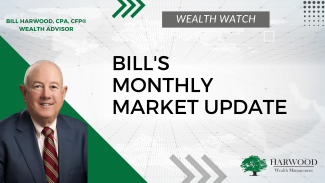
Wealth Watch - Bill's Monthly Market Commentary
As I write this month’s newsletter our government is debating how it spends our tax dollars; and there appears to be a major disagreement. Will there be another government shutdown? We will know by the time you read this. You would think 535 members of Congress could come to agreements that are good for our country. From an investment standpoint here is what you need to know. The S&P 500 has been up 0.04%, on average, during the 21 shutdowns since 1976 lasting an average of eight days, including a partial shutdown in 2018. In other words, do not be overly concerned about a shutdown.
The markets took it on the nose again in September. September has historically been the worst month for the markets; but keep in mind that two of the worst months ever, 1987 and 2001, were in September and they skew the historical numbers. With rising US Treasury yields we got a correction of the equity markets. This is not that bad since after this correction the S&P 500 is still up approximately 13% year to date. I believe that this correction has moved many stocks to an oversold status, and they are primed for a fourth-quarter rebound. Starting in mid-October we will get 3rd quarter earnings reports which will help drive the direction of the market through year-end. More importantly, we are entering the fourth quarter of 2023. The fourth quarter of the year tends to be the best quarter for the S&P 500. I believe that the markets will be higher at year-end than they are now.
We still hear the word Recession thrown around in various media outlets; when and for how long. Yes, there will be a recession in the future. Our economy has always gone through growth and recessionary times. Not only will our economy go through another recession, but it will also go through another period of growth; and the cycle continues. Most recessions last less than a year, so if we enter into a recession, we will get through it in a short order of time. The S&P 500 has had positive returns in 74% of the years since 1926. Instead of worrying about the 24% of the negative years, your investment focus should be on the 76% of the positive years.

